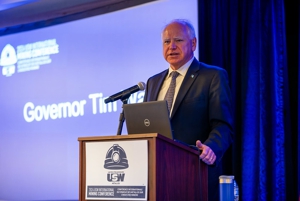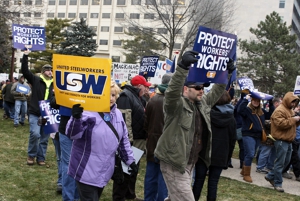Bare Minimum Is Not Enough
Falling real wages is at the heart of what is wrong with America today — economically, politically and morally. We have arrived at a moment when raising wages must be more than a one-time policy prescription. Raising wages must be a framework through which to build a new economic model that is centered on the value of work.
Global leaders from President Obama to Pope Francis recently have decried the dangerous and growing inequality that is defining day-to-day life in America. They are right to sound this alarm, but the shocking inequality in our country is an effect, not a cause. The cause is an economic structure that has disassociated wages from productivity and, in doing so, has broken the basic American social contract — that if you work hard, you can get ahead and enjoy a comfortable life.
America without opportunity is … not America. And the solution is not saying that inequality is somehow inevitable, or that America cannot afford opportunity. The solution is a swift, comprehensive and multifaceted transition to make raising wages the cornerstone of national economic policy and practice.
First, the minimum wage. Let’s be clear: Hiking the federal minimum is long overdue, insufficient to the problem and just a first step. But it is a good first step. Among other benefits, 16.5 million workers who make less than $10.10 would get a raise, and an additional 8 million workers who make slightly more than $10.10 also likely would get a bump. Approximately 900,000 people would be lifted out of poverty.
These are exactly the reasons behind the unprecedented level of state legislative minimum wage activity. In 2013, five states enacted minimum wage increases, and 41 states, plus the District of Columbia, have proposed minimum wage increases in 2014. Ten years ago, we talked about states as the laboratories for innovation; now they also are the proving grounds for implementation, and no issue embodies this evolution more than the minimum wage.
The sheer breadth of this work is telling, and state minimum wage campaigns are just the tip of the iceberg. The effort to raise wages is breaking new ground in dynamic ways. Minimum wage increases and living wage standards are being proposed at the city and county levels. Establishing paid sick days as a standard benefit is gaining momentum, as is aggressively cracking down on corporate wage theft. Tipped workers, who have not gotten a federal increase since 1991, are rightly demanding the same minimum wage as other workers.
Underscoring this progress, diverse groups of workers are embracing collective action. Whether it is independent cab drivers creating new methods of empowerment or workers seeking collective bargaining in traditional employment relations, workers coming together are driving the raising wages movement. It was organized workers who helped create the balance between productivity and wages for many decades, and it is organized workers who will beat back attacks on bargaining power and restore that balance in a new, global economy.
The proof can be found where Americans spend their money. Fast food workers and Walmart workers sparked a national conversation in 2013 about their pay and conditions, with very simple demands like a living wage and predictable scheduling. Plain common sense says it is outrageous that Walmart — the largest employer in America, owned by the richest family in the world — refuses to pay its employees at least $25,000 a year.
Even corporate America is listening. Last month, the Gap announced it would increase its workers’ minimum wage to $9 an hour. While this hourly wage is nowhere near enough for the Gap’s 90,000 affected workers, the decision exposes the greatest economic fraud of our time, which is that employers cannot afford to pay their employees fair wages. Gap’s modest move swings the door wide open to more fundamental change.
We must understand that falling wages is not something confined to the working poor. It is a reality for the majority of America’s workers, for young college graduates and older high school graduates. And falling wages and the concentration of wealth are strangling our economy. We have broken the virtuous cycle in which rising wages drive increased demand, which induces business investment and funds public investment, which leads to increased productivity, which in turn supports rising wages.
Newton’s first law of motion asserts that a body in motion tends to stay in motion. Progressive change in America has always embodied this law. Ideas to better society emerge, gain traction and begin a slow, often inconsistent, but inexorable march toward fruition. Raising wages is a body in motion. So let the debate on increasing the federal minimum wage begin. It is change that America needs, and a harbinger of the real debate over the future of American opportunity.
***
This has been reposted from USA Today.
***
Photo by Richard Drew, AP.
By clicking Sign Up you're confirming that you agree with our Terms and Conditions.
Related Blogs
Ready to make a difference?
Are you and your coworkers ready to negotiate together for bigger paychecks, stronger benefits and better lives?

